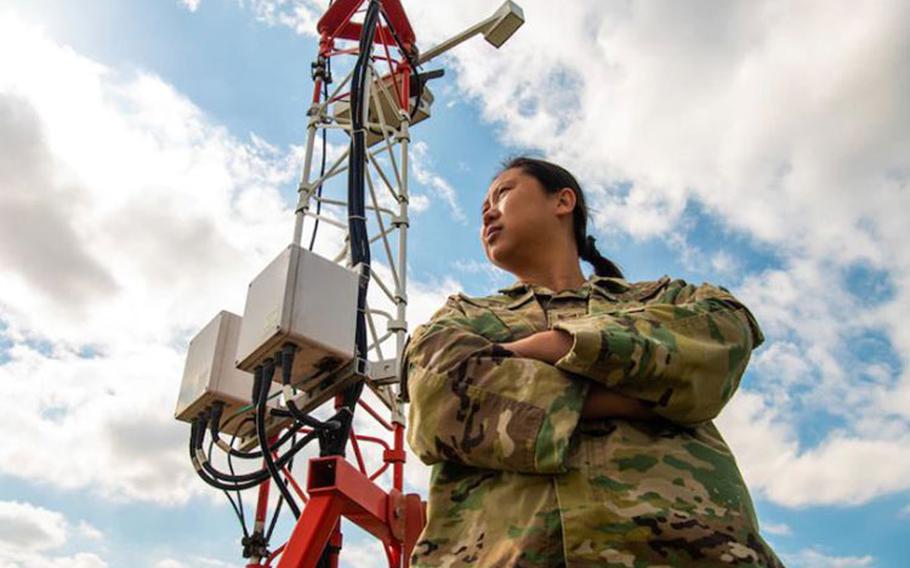Spotlight!
51st OSS weather flight enables Osan to ‘fight tonight’
51st Fighter Wing Public Affairs October 29, 2021

Tech. Sgt. Isabelle Qi, 51st Operations Support Squadron airfield services element non-commissioned officer-in-charge, glances across the airfield at Osan Air Base, Republic of Korea, Oct. 13, 2021. The weather flight provides flight and area weather forecasts for more than 10,000 F-16, A-10, U-2 and transient sorties per year and issues resource protection alerts for approximately $3.4 billion worth of combat-ready assets and 7,200 base personnel. OSW manages $462,000 of fixed and deployable meteorological ()
OSAN AIR BASE, Republic of Korea -- There are many variables that can directly impact the start and/or outcome of a mission, one of them being the weather. It is the job of weather specialists to keep constant watch over the forecast, as well as the conditions that may affect the safety of our pilots and aircrew.
The 51st Operations Support Squadron is one of three squadrons assigned to the 51st Operations Group under the 51st Fighter Wing, Osan Air Base, Republic of Korea. It is the most forward-deployed, permanently assigned operations squadron supporting operational flying units and is responsible for training, flight operations, intelligence, operational plans, airfield management, weather forecasting and air traffic control support to two fighter squadrons, an air mobility squadron and a tenant reconnaissance squadron.
“Weather impacts us all day every day,” said Capt. Bradley Riedel, 51st OSS weather flight commander. “It is our mission as the weather flight to monitor all weather and environmental hazards that could potentially impact base infrastructure 24/7 and, most importantly, our people. Essentially, we are making sure everyone is safe and the mission can go on.”
The weather flight provides flight and area weather forecasts for more than 10,000 F-16, A-10, U-2 and transient sorties per year and issues resource protection alerts for approximately $3.4 billion worth of combat-ready assets and 7,200 base personnel. OSW manages $462,000 of fixed and deployable meteorological equipment and maintains an expeditionary armistice posture.
“We’re here on a mission to defend this peninsula,” said Tech. Sgt. Isabelle Qi, 51st Operations Support Squadron airfield services element non-commissioned officer-in-charge. “We’ve been strategically placed here at Osan for a reason. Our assets here need the intelligence we provide in order to securely maintain those assets.”
Airmen in this career field are required to analyze weather conditions, prepare forecasts, issue weather warnings and brief weather information to pilots. Additionally, they must read and interpret weather satellite imagery, climatology reports, computerized weather prediction models and Doppler weather radar imagery. They must also observe, record and transmit space environment observations and understand war fighter tactics and its relationship to weather conditions.
“At the end of the day, we’re sending up our peers, commanders, friends and fellow Airmen up into the skies,” said Riedel. “We need to make sure we find them a safe operating area to do their mission safely and to come back home safely.”
Due to the mission requirements and needs of the aircrew, the weather flight is split into mission integrated forecasters and airfield service forecasters, so each group may focus more specifically on their assigned tasks. The mission integrated forecasters work directly with the aircrew, while airfield service forecasters take care of the communications aspect and ensuring equipment is working properly.
“The most rewarding thing about my job ties into the customer aspect of it,” said Staff Sgt. Jessica Daly, 51st OSS weather craftsman. “I love being able to work directly with the pilots in the fighter squadron because you’re able to get direct feedback about your predictions, which feels really great especially when you’ve been able to predict a storm down to the exact minute. Those moments are the most rewarding to me.”
Nearly every unit across the installation utilizes the weather flight to ensure the weather is suitable for them to complete their mission, be it flying an aircraft, pouring concrete or training military working dogs outside.
“I am blown away by the weather flight and the team I have here,” said Riedel. “They are charged with the vital tasks of making very important decisions and pushing out critical information in a timely manner and, in my opinion, they do so while operating at the highest level. The communication, collaboration and creativity the flight performs makes me proud every day to be their boss.”
Photo Caption: Tech. Sgt. Isabelle Qi, 51st Operations Support Squadron airfield services element non-commissioned officer-in-charge, glances across the airfield at Osan Air Base, Republic of Korea, Oct. 13, 2021. The weather flight provides flight and area weather forecasts for more than 10,000 F-16, A-10, U-2 and transient sorties per year and issues resource protection alerts for approximately $3.4 billion worth of combat-ready assets and 7,200 base personnel. OSW manages $462,000 of fixed and deployable meteorological equipment and maintains an expeditionary armistice posture.